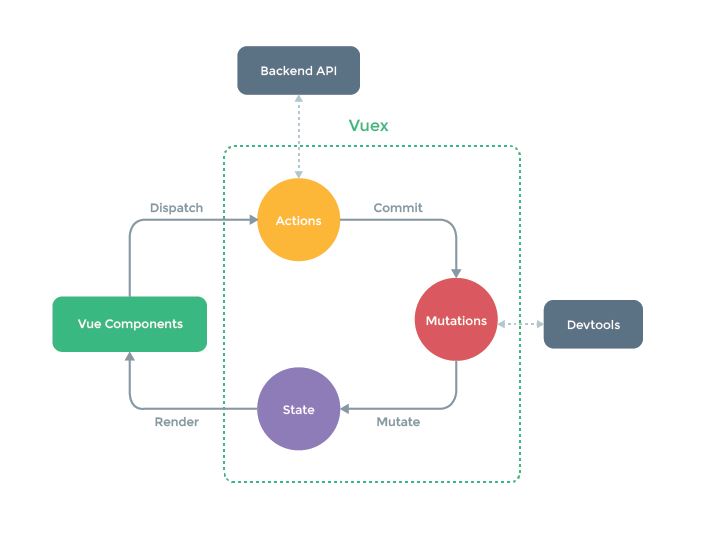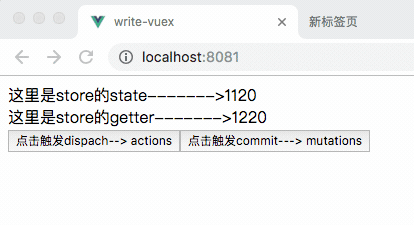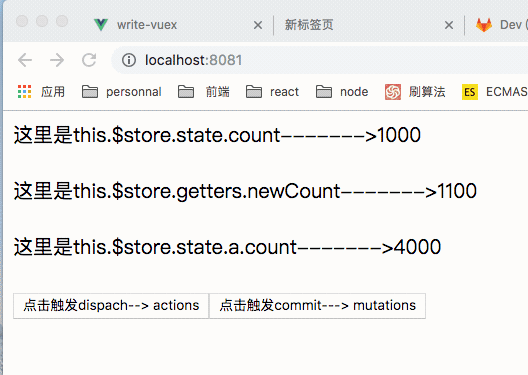您好,登錄后才能下訂單哦!
您好,登錄后才能下訂單哦!
這篇文章給大家分享的是有關vuex工作流程是怎么樣的的內容。小編覺得挺實用的,因此分享給大家做個參考,一起跟隨小編過來看看吧。
大家都知道vuex是vue的一個狀態管理器,它采用集中式存儲管理應用的所有組件的狀態,并以相應的規則保證狀態以一種可預測的方式發生變化。先看看vuex下面的工作流程圖

通過官方文檔提供的流程圖我們知道,vuex的工作流程,
1、數據從state中渲染到頁面;
2、在頁面通過dispatch來觸發action;
3、action通過調用commit,來觸發mutation;
4、mutation來更改數據,數據變更之后會觸發dep對象的notify,通知所有Watcher對象去修改對應視圖(vue的雙向數據綁定原理)。
使用vuex
理解vuex的工作流程我們就看看vuex在vue中是怎么使用的。
首先用vue-cli創建一個項目工程,如下圖,選擇vuex,然后就是一路的回車鍵

安裝好之后,就有一個帶有vuex的vue項目了。
進入目錄然后看到,src/store.js,在里面加了一個狀態{count: 100},如下
import Vue from 'vue'
import Vuex from 'vuex' // 引入vuex
Vue.use(Vuex) // 使用插件
export default new Vuex.Store({
state: {
count: 100 // 加一個狀態
},
getter: {
},
mutations: {
},
actions: {
}
})最后在App.vue文件里面使用上這個狀態,如下
<template>
<div id="app">
這里是stort------->{{this.$store.state.count}}
</div>
</template>
<script>
export default {
name: 'app'
}
</script>
<style>
</style>項目跑起來就會看到頁面上看到,頁面上會有100了,如下圖

到這里我們使用vuex創建了一個store,并且在我們的App組件視圖中使用,但是我們會有一些列的疑問。
store是如何被使用到各個組件上的??
為什么state的數據是雙向綁定的??
在組件中為什么用this.$store.dispch可以觸發store的actions??
在組件中為什么用this.$store.commit可以觸發store的mutations??
....等等等等
帶著一堆問題,我們來自己實現一個vuex,來理解vuex的工作原理。
安裝并使用store
在src下新建一個vuex.js文件,然后代碼如下
'use strict'
let Vue = null
class Store {
constructor (options) {
let { state, getters, actions, mutations } = options
}
}
// Vue.use(Vuex)
const install = _Vue => {
// 避免vuex重復安裝
if (Vue === _Vue) return
Vue = _Vue
Vue.mixin({
// 通過mixins讓每個組件實例化的時候都會執行下面的beforeCreate
beforeCreate () {
// 只有跟節點才有store配置,所以這里只走一次
if (this.$options && this.$options.store) {
this.$store = this.$options.store
} else if (this.$parent && this.$parent.$store) { // 子組件深度優先 父 --> 子---> 孫子
this.$store = this.$parent.$store
}
}
})
}
export default { install, Store }然后修改store.js中的引入vuex模塊改成自己的vuex.js
import Vuex from './vuex' // 自己創建的vuex文件
在我們的代碼中export default { install, Store }導出了一個對象,分別是install和Store
install的作用是,當Vue.use(Vuex)就會自動調用install方法,在install方法里面,我們用mixin混入了一個beforeCreate的生命周期的鉤子函數,使得當每個組件實例化的時候都會調用這個函數。
在beforeCreate中,第一次根組件通過store屬性掛載$store,后面子組件調用beforeCreate掛載的$store都會向上找到父級的$store,這樣子通過層層向上尋找,讓每個組件都掛上了一個$store屬性,而這個屬性的值就是我們的new Store({...})的實例。如下圖

通過層層向上尋找,讓每個組件都掛上了一個$store屬性設置state響應數據
通過上面,我們已經從每個組件都通過this.$store來訪問到我們的store的實例,下面我們就編寫state數據,讓其變成雙向綁定的數據。下面我們改寫store類
class Store {
constructor (options) {
let { state, getters, actions, mutations } = options // 拿到傳進來的參數
this.getters = {}
this.mutations = {}
this.actions = {}
// vuex的核心就是借用vue的實例,因為vuex的數據更改回更新視圖
this._vm = new Vue({
data: {
state
}
})
}
// 訪問state對象時候,就直接返回響應式的數據
get state() { // Object.defineProperty get 同理
return this._vm.state
}
}傳進來的state對象,通過new Vue({data: {state}})的方式,讓數據變成響應式的。當訪問state對象時候,就直接返回響應式的數據,這樣子在App.vue中就可以通過this.$store.state.count拿到state的數據啦,并且是響應式的呢。
編寫mutations、actions、getters
上面我們已經設置好state為響應式的數據,這里我們在store.js里面寫上mutations、actions、getters,如下
import Vue from 'vue'
import Vuex from './vuex' // 引入我們的自己編寫的文件
Vue.use(Vuex) // 安裝store
// 實例化store,參數數對象
export default new Vuex.Store({
state: {
count : 1000
},
getters : {
newCount (state) {
return state.count + 100
}
},
mutations: {
change (state) {
console.log(state.count)
state.count += 10
}
},
actions: {
change ({commit}) {
// 模擬異步
setTimeout(() => {
commit('change')
}, 1000)
}
}
})配置選項都寫好之后,就看到getters對象里面有個newCount函數,mutations和actions對象里面都有個change函數,配置好store之后我們在App.vue就可以寫上,dispatch和commit,分別可以觸發actions和mutations,代碼如下
<template>
<div id="app">
這里是store的state------->{{this.$store.state.count}} <br/>
這里是store的getter------->{{this.$store.getters.newCount}} <br/>
<button @click="change">點擊觸發dispach--> actions</button>
<button @click="change1">點擊觸發commit---> mutations</button>
</div>
</template>
<script>
export default {
name: 'app',
methods: {
change () {
this.$store.dispatch('change') // 觸發actions對應的change
},
change1 () {
this.$store.commit('change') // 觸發mutations對應的change
}
},
mounted () {
console.log(this.$store)
}
}
</script>數據都配置好之后,我們開始編寫store類,在此之前我們先編寫一個循環對象工具函數。
const myforEach = (obj, callback) => Object.keys(obj).forEach(key => callback(key, obj[key]))
// 作用:
// 例如{a: '123'}, 把對象的key和value作為參數
// 然后就是函數運行callback(a, '123')工具函數都準備好了,之后,下面直接縣編寫getters、mutations和actions的實現
class Store {
constructor (options) {
let { state = {}, getters = {}, actions = {}, mutations = {} } = options
this.getters = {}
this.mutations = {}
this.actions = {}
// vuex的核心就是借用vue的實例,因為vuex的數據更改回更新視圖
this._vm = new Vue({
data: {
state
}
})
// 循環getters的對象
myforEach(getters, (getterName, getterFn) => {
// 對this.getters對象進行包裝,和vue的computed是差不多的
// 例如 this.getters['newCount'] = fn(state)
// 執行 this.getters['newCount']()就會返回計算的數據啦
Object.defineProperty(this.getters, getterName, {
get: () => getterFn(state)
})
})
// 這里是mutations各個key和值都寫到,this.mutations對象上面
// 執行的時候就是例如:this.mutations['change']()
myforEach(mutations, (mutationName, mutationsFn) => {
// this.mutations.change = () => { change(state) }
this.mutations[mutationName] = () => {
mutationsFn.call(this, state)
}
})
// 原理同上
myforEach(actions, (actionName, actionFn) => {
// this.mutations.change = () => { change(state) }
this.actions[actionName] = () => {
actionFn.call(this, this)
}
})
const {commit , dispatch} = this // 先存一份,避免this.commit會覆蓋原型上的this.commit
// 解構 把this綁定好
// 通過結構的方式也要先調用這類,然后在下面在調用原型的對應函數
this.commit = type => {
commit.call(this, type)
}
this.dispatch = type => {
dispatch.call(this, type)
}
}
get state() { // Object.defineProperty 同理
return this._vm.state
}
// commi調用
commit (type) {
this.mutations[type]()
}
// dispatch調用
dispatch (type) {
this.actions[type]()
}
}通過上面的,我們可以看出,其實mutations和actions都是把傳入的參數,賦值到store實例上的this.mutations和this.actions對象里面。
當組件中this.$store.commit('change')的時候 其實是調用this.mutations.change(state),就達到了改變數據的效果,actions同理。
getters是通過對Object.defineProperty(this.getters, getterName, {})
對this.getters進行包裝當組件中this.$store.getters.newCount其實是調用getters對象里面的newCount(state),然后返回計算結果。就可以顯示到界面上了。
大家看看完成后的效果圖。

到這里大家應該懂了vuex的內部代碼的工作流程了,vuex的一半核心應該在這里了。為什么說一半,因為還有一個核心概念module,也就是vuex的數據的模塊化。
vuex數據模塊化
由于使用單一狀態樹,應用的所有狀態會集中到一個比較大的對象。當應用變得非常復雜時,store 對象就有可能變得相當臃腫。
為了解決以上問題,Vuex 允許我們將 store 分割成模塊(module)。每個模塊擁有自己的 state、mutation、action、getter、甚至是嵌套子模塊——從上至下進行同樣方式的分割
例如下面的store.js
// 實例化store,參數數對象
export default new Vuex.Store({
modules: {
// 模塊a
a: {
state: {
count: 4000
},
actions: {
change ({state}) {
state.count += 21
}
},
modules: {
// 模塊b
b: {
state: {
count: 5000
}
}
}
}
},
state: {
count : 1000
},
getters : {
newCount (state) {
return state.count + 100
}
},
mutations: {
change (state) {
console.log(state.count)
state.count += 10
}
},
actions: {
change ({commit}) {
// 模擬異步
setTimeout(() => {
commit('change')
}, 1000)
}
}
})然后就可以在界面上就可以寫上this.$store.state.a.count(顯示a模塊count),this.$store.state.a.b.count(顯示a模塊下,b模塊的count),這里還有一個要注意的,其實在組件中調用this.$store.dispatch('change')會同時觸發,根的actions和a模塊的actions里面的change函數。
下面我們就直接去實現models的代碼,也就是整個vuex的實現代碼,
'use strict'
let Vue = null
const myforEach = (obj, callback) => Object.keys(obj).forEach(key => callback(key, obj[key]))
class Store {
constructor (options) {
let state = options.state
this.getters = {}
this.mutations = {}
this.actions = {}
// vuex的核心就是借用vue的實例,因為vuex的數據更改回更新視圖
this._vm = new Vue({
data: {
state
}
})
// 把模塊之間的關系進行整理, 自己根據用戶參數維護了一個對象
// root._children => a._children => b
this.modules = new ModulesCollections(options)
// 無論子模塊還是 孫子模塊 ,所有的mutations 都是根上的
// 安裝模塊
installModules(this, state, [], this.modules.root)
// 解構 把this綁定好
const {commit , dispatch} = this
// 通過結構的方式也要先調用這類,然后在下面在調用原型的對應函數
this.commit = type => {
commit.call(this, type)
}
this.dispatch = type => {
dispatch.call(this, type)
}
}
get state() { // Object.defineProperty 同理
return this._vm.state
}
commit (type) {
// 因為是數組,所以要遍歷執行
this.mutations[type].forEach(fn => fn())
}
dispatch (type) {
// 因為是數組,所以要遍歷執行
this.actions[type].forEach(fn => fn())
}
}
class ModulesCollections {
constructor (options) { // vuex []
// 注冊模塊
this.register([], options)
}
register (path, rawModule) {
// path 是空數組, rawModule 就是個對象
let newModule = {
_raw: rawModule, // 對象
_children: {}, // 把子模塊掛載到這里
state: rawModule.state
}
if (path.length === 0) { // 第一次
this.root = newModule
} else {
// [a, b] ==> [a]
let parent = path.slice(0, -1).reduce((root, current) => {
return root._children[current]
}, this.root)
parent._children[path[path.length - 1]] = newModule
}
if (rawModule.modules) {
// 遍歷注冊子模塊
myforEach(rawModule.modules, (childName, module) => {
this.register(path.concat(childName), module)
})
}
}
}
// rootModule {_raw, _children, state }
function installModules (store, rootState, path, rootModule) {
// rootState.a = {count:200}
// rootState.a.b = {count: 3000}
if (path.length > 0) {
// 根據path找到對應的父級模塊
// 例如 [a] --> path.slice(0, -1) --> [] 此時a模塊的父級模塊是跟模塊
// 例如 [a,b] --> path.slice(0, -1) --> [a] 此時b模塊的父級模塊是a模塊
let parent = path.slice(0, -1).reduce((root, current) => {
return root[current]
}, rootState)
// 通過Vue.set設置數據雙向綁定
Vue.set(parent, path[path.length - 1], rootModule.state)
}
// 設置getter
if (rootModule._raw.getters) {
myforEach(rootModule._raw.getters, (getterName, getterFn) => {
Object.defineProperty(store.getters, getterName, {
get: () => {
return getterFn(rootModule.state)
}
})
})
}
// 在跟模塊設置actions
if (rootModule._raw.actions) {
myforEach(rootModule._raw.actions, (actionName, actionsFn) => {
// 因為同是在根模塊設置,子模塊也有能相同的key
// 所有把所有的都放到一個數組里面
// 就變成了例如 [change, change] , 第一個是跟模塊的actions的change,第二個是a模塊的actions的change
let entry = store.actions[actionName] || (store.actions[actionName] = [])
entry.push(() => {
const commit = store.commit
const state = rootModule.state
actionsFn.call(store, {state, commit})
})
})
}
// 在跟模塊設置mutations, 同理上actions
if (rootModule._raw.mutations) {
myforEach(rootModule._raw.mutations, (mutationName, mutationFn) => {
let entry = store.mutations[mutationName] || (store.mutations[mutationName] = [])
entry.push(() => {
mutationFn.call(store, rootModule.state)
})
})
}
// 遞歸遍歷子節點的設置
myforEach(rootModule._children, (childName, module) => {
installModules(store, rootState, path.concat(childName), module)
})
}
const install = _Vue => {
// 避免vuex重復安裝
if (Vue === _Vue) return
Vue = _Vue
Vue.mixin({
// 通過mixins讓每個組件實例化的時候都會執行下面的beforeCreate
beforeCreate () {
// 只有跟節點才有store配置
if (this.$options && this.$options.store) {
this.$store = this.$options.store
} else if (this.$parent && this.$parent.$store) { // 子組件深度優先 父 --> 子---> 孫子
this.$store = this.$parent.$store
}
}
})
}
export default { install, Store }看到代碼以及注釋,主要流程就是根據遞歸的方式,處理數據,然后根據傳進來的配置,進行操作數據。
至此,我們把vuex的代碼實現了一遍,在我們App.vue的代碼里添加
<template>
<div id="app">
這里是store的state------->{{this.$store.state.count}} <br/>
這里是store的getter------->{{this.$store.getters.newCount}} <br/>
這里是store的state.a------->{{this.$store.state.a.count}} <br/>
<button @click="change">點擊觸發dispach--> actions</button>
<button @click="change1">點擊觸發commit---> mutations</button>
</div>
</template>最后查看結果。

感謝各位的閱讀!關于“vuex工作流程是怎么樣的”這篇文章就分享到這里了,希望以上內容可以對大家有一定的幫助,讓大家可以學到更多知識,如果覺得文章不錯,可以把它分享出去讓更多的人看到吧!
免責聲明:本站發布的內容(圖片、視頻和文字)以原創、轉載和分享為主,文章觀點不代表本網站立場,如果涉及侵權請聯系站長郵箱:is@yisu.com進行舉報,并提供相關證據,一經查實,將立刻刪除涉嫌侵權內容。